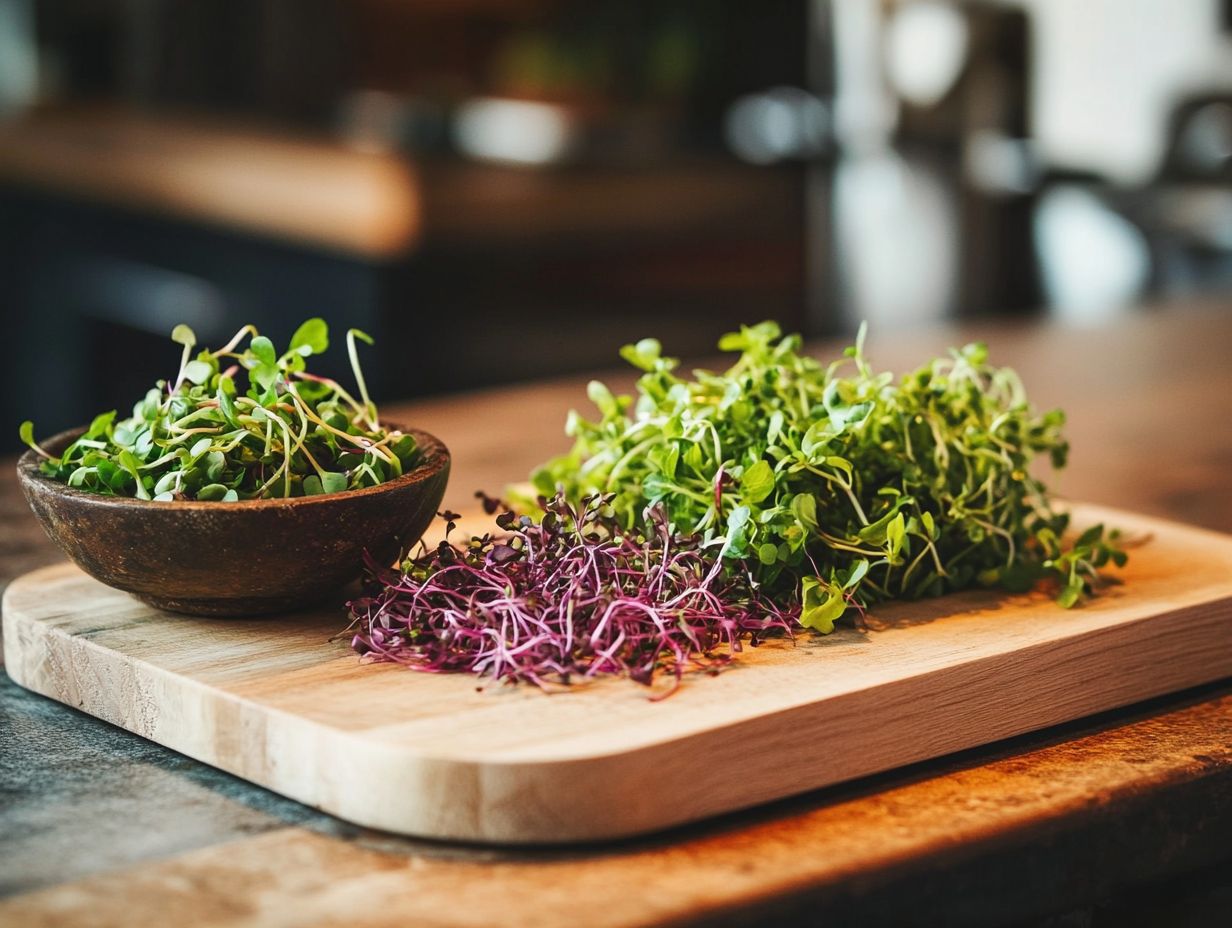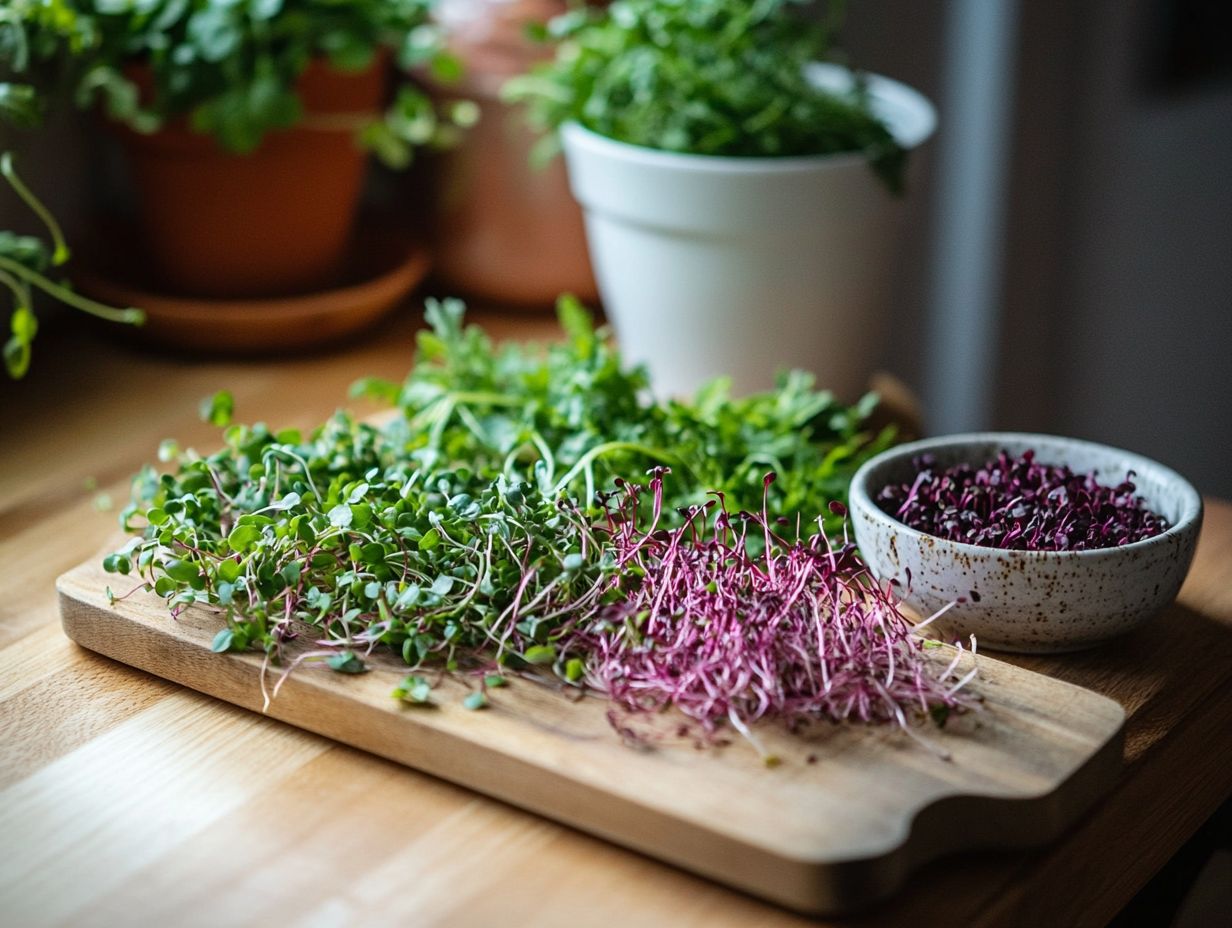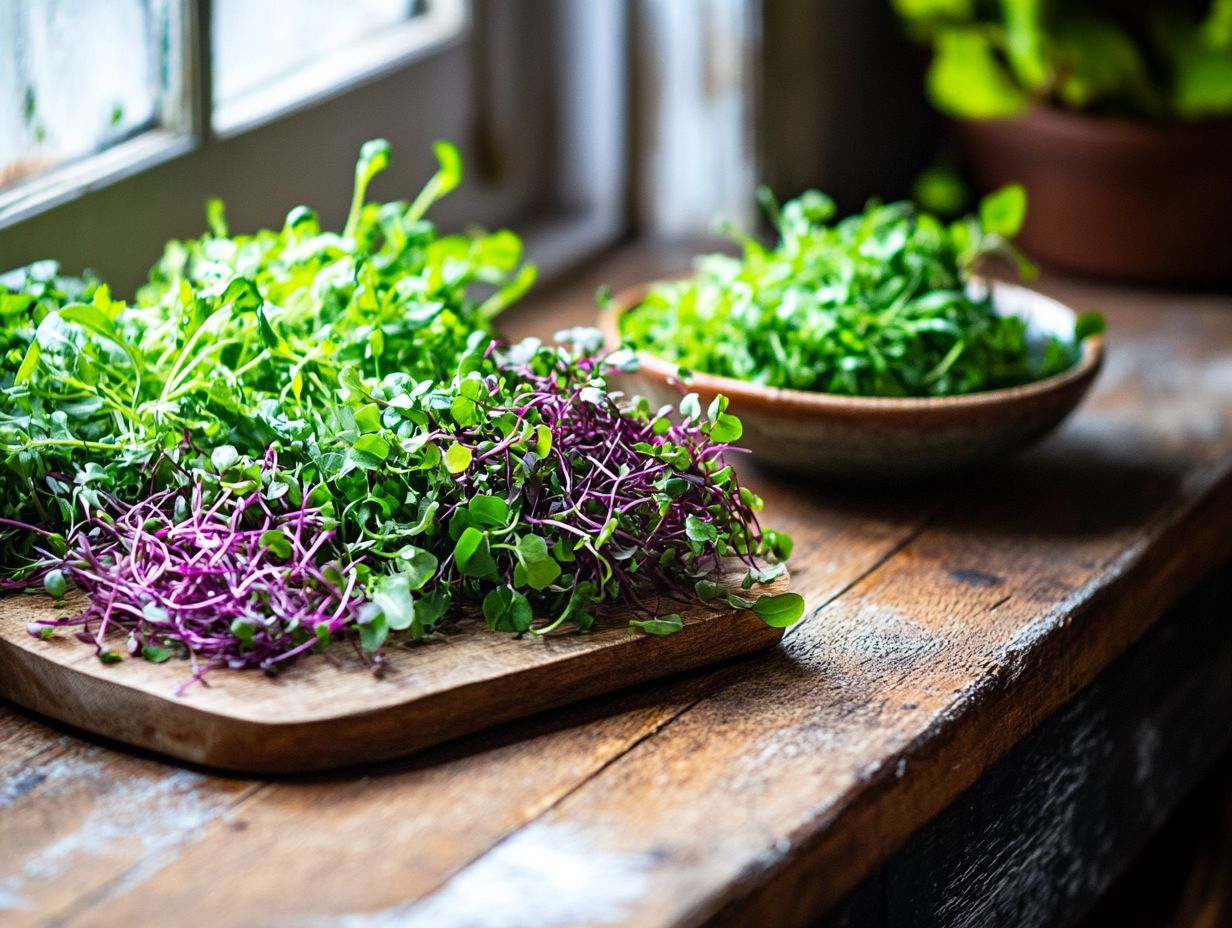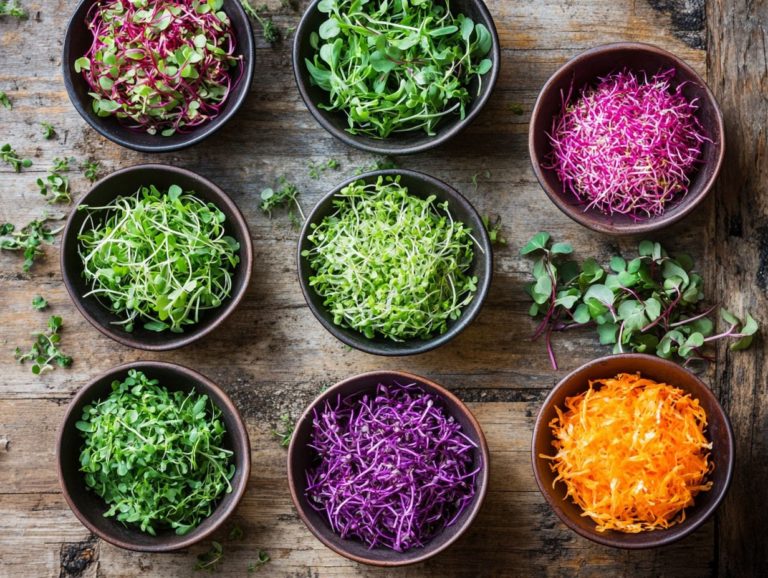62. Microgreens and Nutrition: Cooking Tips
Microgreens are miniature powerhouses, bursting with flavor. They are full of nutrients, making them an irresistible choice for health-conscious individuals who prioritize health in their diet.
This article invites you to explore the diverse types of microgreens and delve into their remarkable nutritional benefits. You will learn how to seamlessly integrate them into your meals.
Whether you re considering growing your own little garden or simply looking to elevate your culinary creations, you ll find practical tips and delectable recipes at your fingertips.
We will also discuss potential risks, ensuring that you can savor these vibrant greens with peace of mind.
Jump in and discover the exciting world of microgreens today!
Contents
Key Takeaways:

- Microgreens are young, edible plants that are packed with nutrients, making them a great addition to any diet.
- Including microgreens in your meals can provide a variety of essential vitamins and minerals to support overall health and well-being.
- With simple cooking tips and recipes, it’s easy to incorporate microgreens into your favorite dishes for added flavor and nutrition.
What are Microgreens?
Microgreens, often dubbed tiny edible greens, are young plants that you can harvest shortly after their first leaves appear. These little powerhouses are full of nutrients, antioxidants, and vitamins, making them an ideal choice for anyone looking to elevate their diet.
Take fenugreek microgreens, for instance. They not only add a burst of flavor but also come with impressive health benefits, such as aiding digestive health and helping to regulate blood sugar. Exploring various microgreen varieties and their culinary uses can elevate your meals even further.
Whether you cultivate them in your home garden or participate in a community plot, these vibrant greens are celebrated for their culinary versatility. From salads to sandwiches and garnishes, they not only enrich your meals with nutrition but also enhance their visual appeal. To learn more about specific types, check out the microgreen varieties that can maximize flavor.
Definition and Types of Microgreens
Microgreens are those young plants you can harvest at the cotyledon stage, which is the first leaves that appear. They come in a delightful array of types, each boasting its own unique flavors and health benefits. These greens are nutrient-dense and often grown from vegetable and herb seeds, adding a splash of color and vitality to your culinary creations.
Consider the popular varieties like fenugreek, a superfood known for its health benefits, along with radish and red cabbage. They don’t just enhance your dishes; they’re also brimming with antioxidants, vitamins, and minerals that can bolster your overall health. To take these flavors even further, explore ways to enhance flavor in microgreens. Fenugreek microgreens, for instance, are celebrated for their potential to improve digestion and support metabolic health. Meanwhile, radish microgreens can give your heart a boost and pack a hefty dose of vitamin C.
Incorporating these greens into salads, sandwiches, and smoothies not only elevates the flavor but also delivers a powerful nutritional punch that can significantly enrich your balanced diet, especially when you explore microgreen varieties and their health benefits.
Nutritional Benefits of Microgreens
Microgreens are nutritional powerhouses, brimming with health benefits that elevate your well-being. These tiny greens are a rich source of vitamins, including vitamin A, vitamin C, and vitamin K, as well as minerals like iron and antioxidants, providing you with an exceptional boost to your overall health.
Key Vitamins and Minerals

Microgreens are a treasure trove of essential vitamins and minerals, including vitamin A, C, K, iron, magnesium, and phosphorus. They re an excellent addition to your balanced diet!
These tiny powerhouses are not just cute; they are packed with nutrients. In fact, they often contain more nutrients than fully grown vegetables, enhancing your health and wellness. For instance, vitamin A supports vision and immune function, while vitamin C is vital for skin health and fights oxidative stress. Vitamin K is essential for bone health and blood clotting. You can learn more about using these nutritious greens by checking out our guide on cooking with microgreen varieties.
Minerals like iron are crucial for transporting oxygen throughout your body. Meanwhile, magnesium is vital for muscle and nerve function. Take fenugreek microgreens, for example; they’re particularly nutrient-dense, offering a wealth of antioxidants that can aid digestion and protect against various diseases.
Don t wait! Add these vibrant microgreens to your meals today and watch your nutritional intake soar!
How to Incorporate Microgreens into Your Diet
Incorporating microgreens into your diet offers a fantastic opportunity to elevate your meals with both flavor and nutrition. These vibrant little greens easily fit into many dishes, whether tossed into salads or blended into smoothies. Transform the ordinary into the extraordinary while promoting weight management!
Cooking Tips and Recipes
When you cook with microgreens, handle them gently to preserve their delicate flavors and nutrients. This makes them ideal for fresh salads, as toppings, or in smoothies.
Incorporating these tiny greens into your meals can elevate the overall flavor profile while adding a vibrant visual appeal. They’re more than a garnish; they’re a delicious upgrade to your meals! Think about blending them into a creamy pesto, sprinkling them over omelets for an immune-boosting addition, or tossing them into soups just before serving. For more ideas, check out this guide on how to incorporate microgreens into your diet.
Their impressive nutrients mean they provide vitamins and antioxidants without overpowering other ingredients. For a refreshing twist, layer microgreens in a grilled vegetable sandwich or use them as a colorful finish to a quinoa bowl, ensuring each bite bursts with freshness! To enhance your growing experience, check out this guide on how to maximize yields from microgreens.
Growing Your Own Microgreens
Growing your own microgreens is not just a hobby; it s a gratifying pursuit that brings fresh, nutrient-rich greens directly to your home or community garden. This endeavor offers you a wealth of health benefits while enhancing your culinary experiences.
Step-by-Step Guide and Tips

To successfully grow microgreens at home, start with high-quality seeds, suitable containers, and a well-draining growing medium. Ensure they receive ample light and moisture.
Selecting the right varieties can elevate your experience. Some seeds germinate faster and boast unique flavors. After choosing your seeds, give them a quick rinse to remove any contaminants, then soak them for a few hours to kickstart the germination. For more information on cultivating microgreen varieties for your health, consider exploring different options.
While that s happening, prepare your containers for your home growing setup. You can use anything from shallow trays to repurposed plastic containers, just ensure they have drainage holes. Once everything is ready, spread the soaked seeds evenly over the medium and lightly cover them before misting with water.
Regularly check humidity levels and provide indirect light or use grow lights, adjusting as necessary based on the microgreens’ growth stage.
Throughout the process, stay vigilant for pests or mold. Adjust your watering schedule to avoid waterlogging while encouraging healthy growth.
Potential Risks and Precautions
While microgreens provide many health benefits, it’s essential to recognize potential risks and adhere to food safety precautions. This way, you can fully enjoy their advantages without compromising your well-being.
Food Safety and Allergy Concerns
Food safety is crucial when enjoying microgreens. Improper handling can lead to foodborne illnesses, which are illnesses caused by contaminated food. Additionally, some individuals may have allergies to specific varieties of microgreens.
You can fully enjoy the health benefits of microgreens by ensuring they are grown and harvested carefully. Always wash your hands, use clean equipment, and ensure proper refrigeration. Following essential tips for growing microgreens at home are crucial for safety.
It’s vital to be aware of common allergens that may be present in microgreens, particularly those from legumes or mustard varieties. Early recognition of potential allergens can help you make informed choices and mitigate health risks. This way, you can savor the nutritious benefits of these vibrant plants, including the best microgreens for nutritional value, without worrying about adverse reactions.
Frequently Asked Questions
What are microgreens?

Microgreens are small, edible plants packed with nutrients. They are harvested after the first true leaves have developed, making them smaller than baby greens but larger than sprouts. These tiny greens are rich in flavor and nutrients.
Why are microgreens considered nutritious?
Microgreens are considered nutritious because they are harvested at a very young stage, when the plant is most nutrient-dense. They contain a higher concentration of vitamins, minerals, and antioxidants compared to mature plants.
What kinds of microgreens can be used for cooking?
Many different types of microgreens can be used for cooking, including arugula, basil, broccoli, kale, and radish. Experiment with various varieties to discover your favorites.
How can microgreens be incorporated into cooking?
Microgreens can be used in a variety of ways in cooking. Add them to salads, use them as garnishes for soups or sandwiches, or top your pizza or pasta with them. You can also blend them into smoothies or incorporate them into stir-fries.
Do microgreens need to be cooked?
No, microgreens do not need to be cooked. They can be eaten raw, which is the best way to preserve their nutrients and flavor. However, they can also be lightly saut ed or used as a garnish for cooked dishes.
How can I store microgreens after purchasing them?
To store microgreens, wrap them in a damp paper towel and place them in a sealed container or bag in the refrigerator. They should stay fresh for about a week. Use them as soon as possible for the best taste and highest nutrients.
Try growing your own microgreens today for fresh flavor in your meals!






